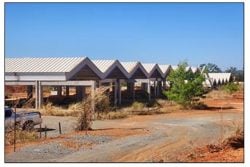The Dominican Republic (DR), the Caribbean nation that shares the island of Hispaniola with Haiti, is a popular tourist destination. Known for its beaches, all-inclusive resorts, golf courses, food and robust hospitality, it has become one of the premier sought-after vacation sites by couples and groups. One of the things the casual tourist does not see, however, is the deforestation that is rife in the island state – just as it is in neighbouring Haiti. Unlike its politically-unstable neighbour though, the DR is currently benefiting from a huge reforestation project that involves shade (timber) and fruit trees being planted throughout the country. One of the objectives of this programme is to improve water resiliency, through transpiration from the trees. The DR is also plagued with water shortages, affecting primarily the local population.
Compared to Haiti and the DR, Guyana can be considered blessed given its verdant forested areas. Yet, with the vagaries of climate change – like droughts and forest fires for instance – as constant reminders, we would do well not to rest on our laurels and believe that what is abundant will always remain that way. Indeed, planning, conservation, and careful stewardship of forest resources are absolutely necessary. Were the Iwokrama rainforest not protected and monitored, for instance, untold damage could be done there.
History has served to make us all cognisant of the effects of greed on the planet. In fact, the significant devastation of sections of the Amazon rainforest to facilitate mining of minerals and farming over recent years is a clear and present reminder of avarice overriding the survival instinct and basic common sense. Fortunately, for now, the latter is prevailing and the DR and the Amazon are not the only areas in the world where restoration is a priority.
Kenya, Senegal and Mali are only some of the countries in Africa where carefully monitored tree planting is underway with the aim of alleviating ecological and economic problems. Similar projects are also being undertaken around Europe and in the United States to sequester carbon, improve air quality, and help absorb water when storms hit. Aside from forests, wooded areas and parks, tree planting is also being used to serve practical purposes like increasing canopy cover in poor neighbourhoods. Studies have found that trees help to boost better health outcomes in humans such as improved cognitive function, stable blood pressure, and good mental health. In general, access to nature assists with physical activity and sleep.
Years ago, being called a tree hugger was akin to an insult. Today, knowledge has reinforced the awareness that trees are important to life. They absorb harmful pollutants and release oxygen, improving air quality. They store carbon, provide cool and shade and help prevent water pollution and soil erosion. Trees supply food for many species, including humans and offer shelter to fauna, especially birds.
There is some amount of symbolism surrounding tree planting. In the United States, there is a day dedicated to this endeavour. Proposed by nineteenth century newspaper editor and politician J Sterling Morton, who editorialised that “trees would serve as effective windbreaks, protecting crops from erosion and overexposure to the sun and would provide fuel and building materials,” it was first celebrated in Nebraska in April 1872 with the planting of over one million trees. Arbor Day has been observed annually since then throughout the country. In some states, the month varies depending on the weather. It has also spread beyond the US to other countries.
Earth Day, which saw its 54th annual international observation on April 22 this year, is also another occasion on which trees are planted symbolically as is World Environment Day, celebrated on June 5. In addition, trees are regularly planted as milestone markers for historical events, birth and death anniversaries of heroic figures and sometimes to launch projects.
Given their usefulness and value to the continued existence of our lives as well as the planet, the imperative of planting trees can never be overemphasised. Degraded forests must absolutely be replanted and wooded areas encouraged. Man-groves should be grown and preserved to serve as coastal protection. The ceremonial planting of shade and flowering trees for commemoration and beautification should even become synonymous with special occasions.
However, there’s more that could be done, particularly here in Guyana. What if, in collaboration with the Ministry of Agriculture, each new home owner received not just a set of keys, but also the sapling of a fruit tree homogenous to the soil in the area that the family could enjoy for years to come? These could be citrus, mango, breadfruit, avocado, sapodilla, carambola and or other such trees that are easy to grow. Of course, families could plant others if they chose to. In fact, they should be encouraged to do so.
Such an initiative would mesh well with the government’s new slant on the old theme of self-sufficiency. The cost would be minimal and the benefits boundless, extending beyond generations. To paraphrase Rabindranath Tagore, those who plant trees, knowing that they will never sit in their shade (or reap the fruits), have at least started to understand the meaning of life.



